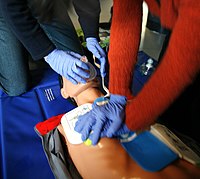
Photo from wikipedia
We implemented the World Health Organization surgical safety checklist at Auckland City Hospital from November 2007. We hypothesised that the checklist would reduce postoperative mortality and increase days alive and… Click to show full abstract
We implemented the World Health Organization surgical safety checklist at Auckland City Hospital from November 2007. We hypothesised that the checklist would reduce postoperative mortality and increase days alive and out of hospital, both measured to 90 postoperative days. We compared outcomes for cohorts who had surgery during 18-month periods before vs. after checklist implementation. We also analysed outcomes during 9 years that included these periods (July 2004-December 2013). We analysed 9475 patients in the 18-month period before the checklist and 10,589 afterwards. We analysed 57,577 patients who had surgery from 2004 to 2013. Mean number of days alive and out of hospital (95%CI) in the cohort after checklist implementation was 1.0 (0.4-1.6) days longer than in the cohort preceding implementation, p < 0.001. Ninety-day mortality was 395/9475 (4%) and 362/10,589 (3%) in the cohorts before and after checklist implementation, multivariable odds ratio (95%CI) 0.93 (0.80-1.09), p = 0.4. The cohort changes in these outcomes were indistinguishable from longer-term trends in mortality and days alive and out of hospital observed during 9 years, as determined by Bayesian changepoint analysis. Postoperative mortality to 90 days was 228/5686 (4.0%) for Māori and 2047/51,921 (3.9%) for non-Māori, multivariable odds ratio (95%CI) 0.85 (0.73-0.99), p = 0.04. Māori spent on average (95%CI) 1.1 (0.5-1.7) fewer days alive and out of hospital than non-Māori, p < 0.001. In conclusion, our patients experienced improving postoperative outcomes from 2004 to 2013, including the periods before and after implementation of the surgical checklist. Māori patients had worse outcomes than non-Māori.
Journal Title: Anaesthesia
Year Published: 2021
Link to full text (if available)
Share on Social Media: Sign Up to like & get
recommendations!